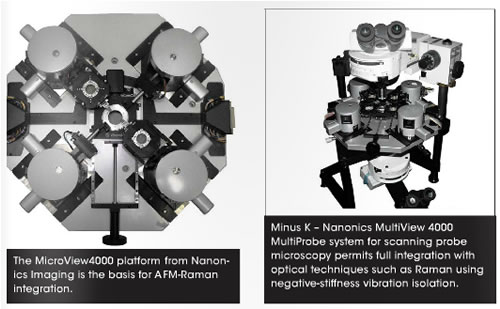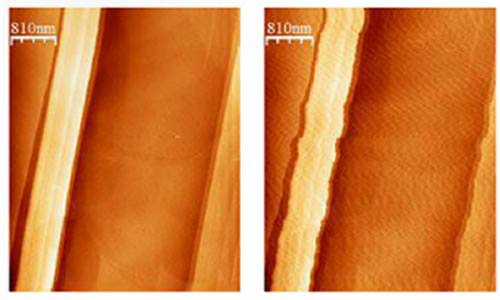|

Lab Product
News - February 2014
Improving Nano-Scale Imaging
Negative-Stiffness vibration isolators can easily support the heavy weight of a combined
AFM/micro-Raman system, and isolate it from low frequency vibrations more effectively than
high-performance air tables or active isolation systems.
The need for precise vibration isolation with scanning probe microscopy (SPM) and near-field scanning optical microscopy (HSOM) systems is becoming more critical as resolutions continue to bridge from micro to nano. Whether used in academic labs or commercial facilities, SPM and NSOM systems are extremely susceptible to vibrations from the environment. When measuring a very few angstroms or nanometers of displacement, an absolutely stable surface must be established for the instrument. Any vibration coupled into the mechanical structure of the instrument will cause vertical and/or horizontal noise and bring about a reduction in the ability to measure high resolution features - the vertical axis being the most sensitive for SPMs, but they can also be quite sensitive to vibrations in the horizontal axis.
Traditionally, high-performance air tables have been the vibration isolators most used for SPM and NSOM work. The ubiquitous passive-system air tables, adequate until a decade ago, are now being seriously challenged by the need for more refined imaging requirements. Bench-top air systems provide limited isolation vertically and very little isolation horizontally. Also at a disadvantage are the active isolation systems, known as electronic force cancellation, that use electronics to sense the motion and then put in equal amounts of motion electronically to compensate and cancel out the motion. Active systems are adequate for applications with lasers and optics, as they can start isolating as low as 0.7 Hz, but because they run on electricity they can be negatively influenced by problems of electronic dysfunction and power modulations, which can interrupt scanning.
Lately, the introduction of integrated microscopy systems employing multiple microscopes is enabling more complex optical measurements, but these systems are also much heavier, and there has been little vibration isolation technology available for such heavy instrumentation.
Negative-stiffness-mechanism vibration isolation is well adapted for SPM and NSOM systems, particularly in applications using atomic force microscopy (AFM) integrated with micro-Raman spectroscopy. In fact, it is the application of negative-stiffness isolation that has enabled AFMs to be truly integrated with micro-Raman into one combined system. Negative-stiffness isolators can handle the heavy weight of the combined AFM/micro-Roman system, as well as isolate the equipment from low frequency vibrations, a critical set of factors that high-performance air tables and active systems cannot achieve.

AFM integrated with micro-Raman
The integration of AFM with micro-Raman enables a sizable improvement in data correlation between the two techniques and expanded Raman measurement and resolution capabilities. Micro-Raman is a spectroscopic NSOM technique used in condensed matter physics and chemistry to study vibrational, rotational, and other low-frequency modes in a system. It relies on scattering of monochromatic light, usually from a laser in the visible, near infrared or near ultraviolet range. The laser light interacts with phonons or other excitations in the system, resulting in the energy of the laser photons being shifted up or down the shift in energy gives information about the phonon modes in the system.
Scanning samples in a micro-Raman system, however suffer from several problems. As a sample is scanned, even a very flat sample. it is hard to keep the distance of the lens to the sample constant. Thus, as one goes from pixel to pixel under the lens of a Raman, a mixture of sample and air is sampled in the voxel (volumetric picture element) that is illuminated. This causes intensity variations in the Raman that are unrelated to the chemical composition of the sample and are artifactual.
The atomic force microscope, being a very high-resolution type of scanning probe microscope, has demonstrated resolution of fractions of a nanometer, making it one of the foremost tools for imaging, measuring and manipulating matter at the nano-scale sharp tip (probe) at its end that is used to scan the specimen surface. When the tip is brought into proximity of a sample surface, forces between the tip and the sample lead to a deflection of the cantilever Resultant characteristics, such as mechanical, electrostatic, magnetic, chemical and other forces are then measured by the AFM using, typically, a laser spot reflected from the top surf ace of the cantilever into an array of photodiodes.
Most systems employing AFM in concert with Raman perform separately, executing either on AFM scan or a Raman scan independently. The recently developed direct integration of Raman spectroscopy with AFM technique, however has opened the door to significantly improved technique and sample analyses.
Micro-Raman is a micro-technique, but when AFM is added, it becomes a nano-technique. It allows the AFM structural data to be recorded online and improves the resolution of the Raman information when the nanometric feedback of the system adjusts, with unprecedented precision, the position of each pixel of the sample relative to the lens. Also the small movements of the AFM stage provide oversampling which is a well-known technique for resolution improvement. One integrated AFM-Raman system developed by Nanonics Imaging in association with major Raman manufacturers such as Renishaw, Horiba JY and others provides simultaneous and, very importantly, online data from both modalities. This advantage addresses critical problems in Raman including resolution and intensity comparisons in Raman images while permitting online functional characterization such as thermal conductivity, elasticity and adhesion, electrical and other properties.
Negative-stiffness vibration isolation
Underlying this integration of AFM with micro-Raman is negative-stiffness vibration isolation, developed by Minus K Technology. It provides improved transmissibility of a negative-stiffness isolator - that is the vibrations that transmit through the isolator relative to the input floor vibrations.
Negative-stiffness isolators employ a completely mechanical concept in low-frequency vibration isolation. Vertical-motion isolation is provided by a stiff spring that supports a weight load, combined with a negative-stiffness mechanism. The net vertical stiffness is made very low without affecting the static load-supporting capability of the spring, Beam-columns connected in series with the vertical-motion isolator provide horizontal-motion isolation. The horizontal stiffness of the beam-columns is reduced by the "beam-column" effect (A beam-column behaves as a spring combined with a negative-stiffness mechanism),The result is a compact passive isolator capable of Underlying this integration of AFM with micro-Raman is negative-stiffness vibration isolation, developed by Minus K Technology. It provides improved transmissibility of a negative-stiffness isolator - that is the vibrations that transmit through the isolator relative to the input floor vibrations. Negative-stiffness isolators employ a completely mechanical concept in low-frequency vibration isolation. Vertical-motion isolation is provided by a stiff spring that supports a weight load, combined with a negative-stiffness mechanism. The net vertical stiffness is made very low without affecting the static load-supporting capability of the spring, Beam-columns connected in series with the vertical-motion isolator provide horizontal-motion isolation. The horizontal stiffness of the beam-columns is reduced by the "beam-column" effect (A beam-column behaves as a spring combined with a negative-stiffness mechanism). The result is a compact passive isolator capable low vertical and horizontal natural frequencies and very high internal structural frequencies. The isolators (adjusted to 1/2 Hz) achieve 93% isolation efficiency at 2 Hz; 99% at 5 Hz; and 99.7% at 10 Hz.
"Before negative-stiffness vibration isolation was employed, AFM used in conjunction with micro-Raman systems could not maintain adequate imaging integrity while measuring at the nano-scale level" says Aaron Lewis, president of Nanonics Imaging."Vibration isolation is absolutely necessary for the system's successful performance, and negative-stiffness isolation has enabled AFM and micro-Raman to function as a truly integrated platform." LPN
About the author: Jim McMahon writes on instrumentation technology.
AFN Noise Test
A well-know noise Test in atomic force microscopy (AFM) systems is based on imaging atomic steps in highly oriented pyrolytic graphite (HOPG) substrate. The test measures single (0.34nm) and multiple steps of carbon atoms on me surface while monitoring The peak To peck noise.

The above test has been implemented on in an AFM/Raman system and two AFM scans were performed in two scenarios when the AFM head was mounted on Minus K vibration isolation platform (left image) and when mounted on optical non-floating Table (right). Both images were taken when The Raman was in operation.
About the author: Jim McMahon writes on instrumentation technology.
PDF
version of this article
Top |
